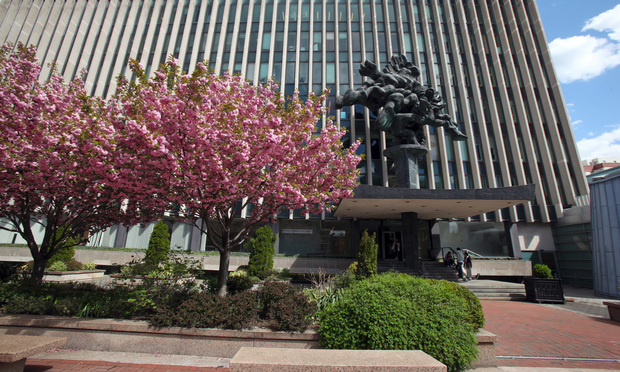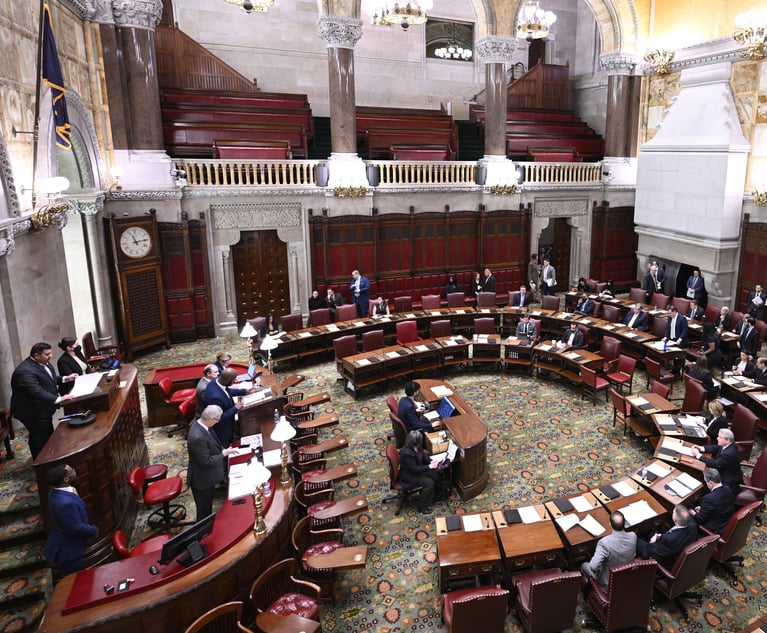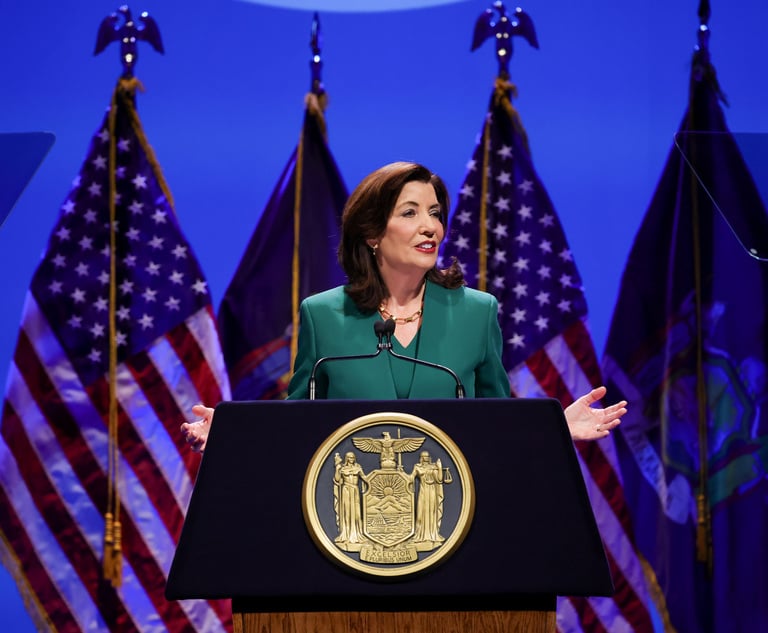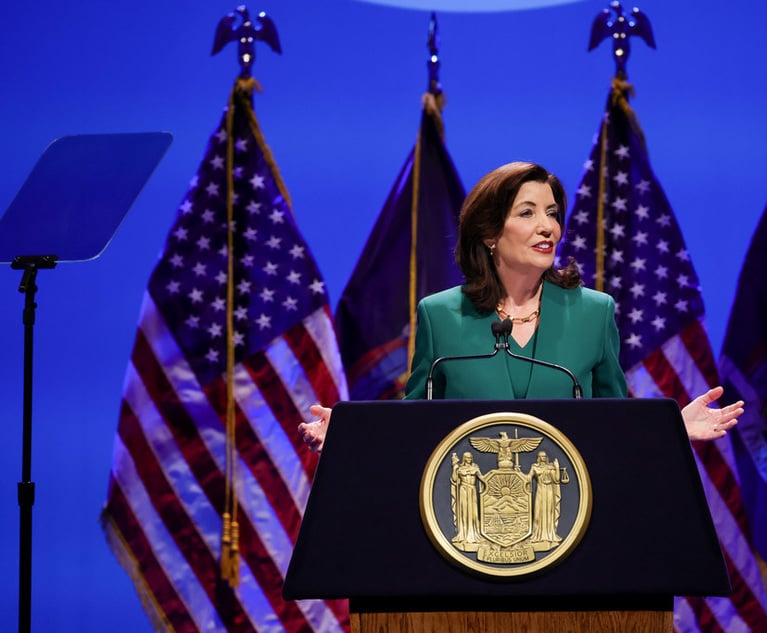Judges Head Back to School to Prepare for Presumptive Mediation Initiative
When officials from the state Office of Court Administration asked if professor Alexandra Carter would be open to having the judges sit in this year, she jumped at the idea.
October 09, 2019 at 02:47 PM
5 minute read
 Columbia Law School. Photo: Bruce Gilbert
Columbia Law School. Photo: Bruce Gilbert
Judges in New York are hitting the books and heading back to school to prepare for an incoming initiative that will require most civil litigants to try resolving their cases through mediation.
A handful of jurists, mostly from the New York City Civil Court, sat alongside students at Columbia Law School last month to brush up their knowledge on mediation, and how it's used.
That training was held over two weeks at the Columbia Law School Mediation Clinic, which was the first institution to deliver training to judges this year in preparation for the state's initiative on presumptive ADR, or alternative dispute resolution.
Professor Alexandra Carter, the former director of clinical education at Columbia Law School, leads the training every semester. When officials from the state Office of Court Administration asked if she would be open to having the judges sit in this year, she jumped at the idea.
"I was really impressed because here you have some really senior judicial leaders, who have been on the bench since I matriculated from Columbia Law as a student, coming back to model learning and really immerse themselves in mediation," Carter said.
Five judges signed up for the training, along with Lisa Denig, who's special counsel for ADR Initiatives at OCA.
Among those jurists were Judge Anthony Cannataro, the administrative judge of the New York City Civil Court.
"The reason why I went is because I'm the person responsible for rolling out the ADR plan in the New York City Civil Court, and mediation is certainly a big part of ADR," Cannatarro said. "I wanted to increase my knowledge of that."
He was joined at the training by Justices Debra Samuels and Carol Sharpe, both from the New York City Civil Court, Bronx Housing Court Justice David Bryan and Westchester Surrogate's Court Justice Brandon Sall.
Carter said it's common for her students to be paired with professionals outside Columbia Law School when she holds the training each semester. People regularly attend from the Civilian Complaint Review Board, for example, and they've had attendees from the United Nations.
"I think it really makes it a rich experience for both the students and the outside professionals to be partnered together and see different ways of looking at problems," Carter said.
But this was the first time so many senior and judicial administrative leaders attended the training, she said. Despite their attendance, Carter said she chose not to alter the format of the training.
"It was a wonderful experience because the judges brought so much knowledge to bear," Carter said. "So, the discussion was elevated but we teach the same skills, the same process, and the same values no matter who is in the room."
Cannatarro said judges who've spent years on the bench without training in mediation might have a different view of what the practice actually is. That's another part of what fueled his interest in attending the training. Cannatarro said he'd previously been told by mediation experts that what he does, in court, is an entirely different procedure than what's practiced in alternative dispute resolution.
"I wanted to understand the difference between the traditional form of mediation, how it's envisioned by the experts in that field versus what I do day-to-day on the bench," Cannatarro said. "It was, actually, tremendously different from what I do."
The training course isn't just informational; it also provides students and others with the first part of their credentials to mediate in New York state. The training is held over two weeks for a total of about 35 hours for participants.
Carter said anyone taking the course, including the judges, learn just about everything about the practice, including the stages of mediation, the component skills, the goals of the process, and the ethical obligations of mediators.
"It's a soup to nuts training, so everything from before we sit down, the moment we're told we're mediating the case, all the way through how you write a mediation agreement, how that's enforced, and how we thank the parties," Carter said.
A lot of that includes practice. For about half the course, attendees are practicing the skills they're learning from the course, Carter said. Judges were paired, at times, with students from Columbia Law School and had coaches available to guide them through the process.
"It's that type of hands-on approach that we find is really the best for training mediators, because some of the best learning takes place in that moment," Carter said.
It's not the first time judges within the state court system have been trained in mediation, but Cannatarro said he hopes other jurists will sign up for a similar course as the state begins its implementation of presumptive ADR.
"Hopefully we'll have a lot of judges who will have taken this training," Cannatarro said.
Carter said she would welcome any judge that wants to take the course at Columbia, which will offer the training again in January and each semester thereafter.
Implementation of the state's ADR program is underway now for portions of the local plans, according to a spokesman for OCA. The remaining portions of the plans are being finalized.
READ MORE:
New York Courts to Begin Presumptive Mediation for Civil Cases Later This Year
OCA Names Justice Vito Caruso as New Administrator for Courts Outside NYC
NY Sees Progress on Court Backlog as 'Excellence Initiative' Enters Fourth Year
This content has been archived. It is available through our partners, LexisNexis® and Bloomberg Law.
To view this content, please continue to their sites.
Not a Lexis Subscriber?
Subscribe Now
Not a Bloomberg Law Subscriber?
Subscribe Now
NOT FOR REPRINT
© 2025 ALM Global, LLC, All Rights Reserved. Request academic re-use from www.copyright.com. All other uses, submit a request to [email protected]. For more information visit Asset & Logo Licensing.
You Might Like
View All
Relaxing Penalties on Discovery Noncompliance Allows Criminal Cases to Get Decided on Merit
5 minute read
Bipartisan Lawmakers to Hochul Urge Greater Student Loan Forgiveness for Public-Interest Lawyers

'Playing the Clock'?: Hochul Says NY's Discovery Loophole Is to Blame for Wide Dismissal of Criminal Cases

So Who Won? Congestion Pricing Ruling Leaves Both Sides Claiming Victory, Attorneys Seeking Clarification
4 minute readTrending Stories
- 1Is It Time for Large UK Law Firms to Begin Taking Private Equity Investment?
- 2Federal Judge Pauses Trump Funding Freeze as Democratic AGs Launch Defensive Measure
- 3Class Action Litigator Tapped to Lead Shook, Hardy & Bacon's Houston Office
- 4Arizona Supreme Court Presses Pause on KPMG's Bid to Deliver Legal Services
- 5Bill Would Consolidate Antitrust Enforcement Under DOJ
Who Got The Work
J. Brugh Lower of Gibbons has entered an appearance for industrial equipment supplier Devco Corporation in a pending trademark infringement lawsuit. The suit, accusing the defendant of selling knock-off Graco products, was filed Dec. 18 in New Jersey District Court by Rivkin Radler on behalf of Graco Inc. and Graco Minnesota. The case, assigned to U.S. District Judge Zahid N. Quraishi, is 3:24-cv-11294, Graco Inc. et al v. Devco Corporation.
Who Got The Work
Rebecca Maller-Stein and Kent A. Yalowitz of Arnold & Porter Kaye Scholer have entered their appearances for Hanaco Venture Capital and its executives, Lior Prosor and David Frankel, in a pending securities lawsuit. The action, filed on Dec. 24 in New York Southern District Court by Zell, Aron & Co. on behalf of Goldeneye Advisors, accuses the defendants of negligently and fraudulently managing the plaintiff's $1 million investment. The case, assigned to U.S. District Judge Vernon S. Broderick, is 1:24-cv-09918, Goldeneye Advisors, LLC v. Hanaco Venture Capital, Ltd. et al.
Who Got The Work
Attorneys from A&O Shearman has stepped in as defense counsel for Toronto-Dominion Bank and other defendants in a pending securities class action. The suit, filed Dec. 11 in New York Southern District Court by Bleichmar Fonti & Auld, accuses the defendants of concealing the bank's 'pervasive' deficiencies in regards to its compliance with the Bank Secrecy Act and the quality of its anti-money laundering controls. The case, assigned to U.S. District Judge Arun Subramanian, is 1:24-cv-09445, Gonzalez v. The Toronto-Dominion Bank et al.
Who Got The Work
Crown Castle International, a Pennsylvania company providing shared communications infrastructure, has turned to Luke D. Wolf of Gordon Rees Scully Mansukhani to fend off a pending breach-of-contract lawsuit. The court action, filed Nov. 25 in Michigan Eastern District Court by Hooper Hathaway PC on behalf of The Town Residences LLC, accuses Crown Castle of failing to transfer approximately $30,000 in utility payments from T-Mobile in breach of a roof-top lease and assignment agreement. The case, assigned to U.S. District Judge Susan K. Declercq, is 2:24-cv-13131, The Town Residences LLC v. T-Mobile US, Inc. et al.
Who Got The Work
Wilfred P. Coronato and Daniel M. Schwartz of McCarter & English have stepped in as defense counsel to Electrolux Home Products Inc. in a pending product liability lawsuit. The court action, filed Nov. 26 in New York Eastern District Court by Poulos Lopiccolo PC and Nagel Rice LLP on behalf of David Stern, alleges that the defendant's refrigerators’ drawers and shelving repeatedly break and fall apart within months after purchase. The case, assigned to U.S. District Judge Joan M. Azrack, is 2:24-cv-08204, Stern v. Electrolux Home Products, Inc.
Featured Firms
Law Offices of Gary Martin Hays & Associates, P.C.
(470) 294-1674
Law Offices of Mark E. Salomone
(857) 444-6468
Smith & Hassler
(713) 739-1250






